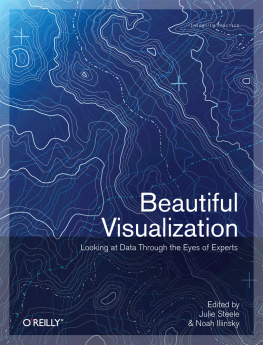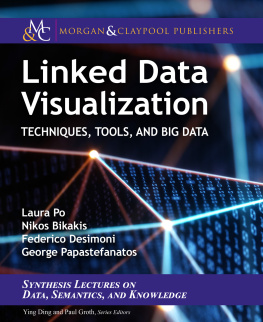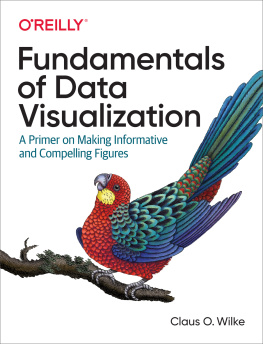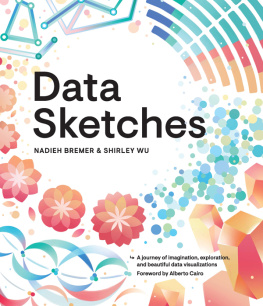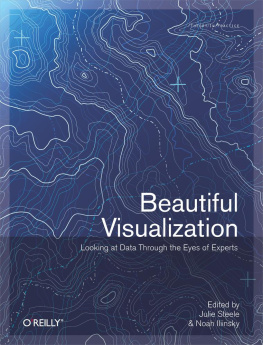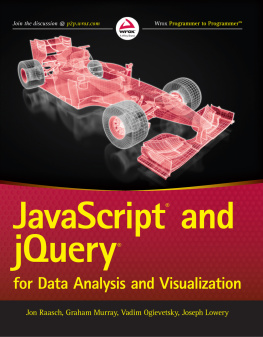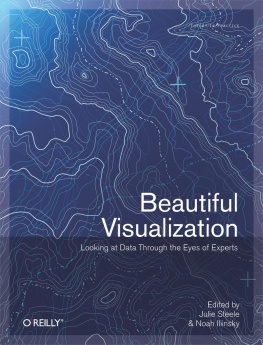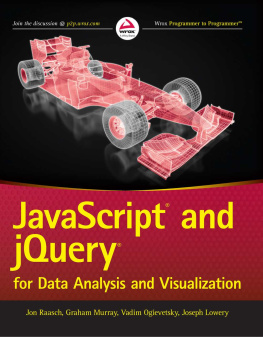Beautiful Visualization
Edited by Julie Steele and Noah Iliinsky
Beijing Cambridge Farnham Kln Sebastopol Taipei Tokyo
Beautiful Visualization
Edited by Julie Steele and Noah Iliinsky
Copyright 2010 OReilly Media, Inc. All rights reserved.
Published by OReilly Media, Inc., 1005 Gravenstein Highway North, Sebastopol, CA 95472.
OReilly books may be purchased for educational, business, or sales promotional use. Online editions are also available for most titles (http://my.safaribooksonline.com). For more information, contact our corporate/institutional sales department: (800) 998-9938 or corporate@oreilly.com.
Editor: Julie Steele
Production Editor: Rachel Monaghan
Copyeditor: Rachel Head
Proofreader: Rachel Monaghan
Indexer: Julie Hawks
Cover Designer: Karen Montgomery
Interior Designer: Ron Bilodeau
Illustrator: Robert Romano
The OReilly logo is a registered trademark of OReilly Media, Inc. Beautiful Visualization, the cover image, and related trade dress are trademarks of OReilly Media, Inc.
Many of the designations used by manufacturers and sellers to distinguish their products are claimed as trademarks. Where those designations appear in this book, and OReilly Media, Inc. was aware of a trademark claim, the designations have been printed in caps or initial caps.
While every precaution has been taken in the preparation of this book, the publisher and authors assume no responsibility for errors or omissions, or for damages resulting from the use of the information contained herein.
ISBN: 978-1-449-37986-5
Preface
This book found its beginnings as a natural outgrowth of Toby Segaran and Jeff Hammerbachers Beautiful Data (OReilly), which explores everything from data gathering to data storage and organization and data analysis. While working on that project, it became clear to us that visualizationthe practice of presenting information for consumption as artwas a topic deep and wide enough to warrant a separate examination. When done beautifully, successful visualizations are deceptive in their simplicity, offering the viewer insight and new understanding at a glance. We hoped to help those new to this growing field uncover the methods and decision-making processes experts use to achieve this end.
Particularly intriguing when assembling a list of potential contributors was how many ways the word beautiful can be interpreted. The book that founded this series, Andy Oram and Greg Wilsons Beautiful Code (OReilly), defined beauty as a simple and elegant solution to some kind of problem. But visualizationas a combination of information and artnaturally combines both problem solving and aesthetics, allowing us to consider beauty in both the intellectual and classic senses.
We hope you will be as delighted as we are by the diversity of backgrounds, projects, and approaches represented in this book. Different as they are, the chapters do offer some themes to the thoughtful and observant. Look for ideas about storytelling, color use, levels of granularity in the data, and user exploration woven throughout the book. Tug on these threads, and see where they take you in your own work.
The royalties for this book are being donated to Architecture for Humanity ( http://www.architectureforhumanity.org ), an organization dedicated to making the world better by bringing design, construction, and development services to the places where they are most critically needed. We hope youll consider how your own design processes shape the world.
How This Book Is Organized
Heres a preview of what youll find in this book:
Chapter 1, , by Noah Iliinsky, offers an examination of what we mean by beauty in the context of visualization, why its a worthy goal to pursue, and how to get there.
Chapter 2, : The Importance of Storytelling in Information Visualization , by Matthias Shapiro, explains the importance of storytelling to visualization and walks readers through the creation of a simple visualization project they can do on their own.
Chapter 3, , by Jonathan Feinberg, explains the inner workings of his popular method for visualizing a body of text, discussing both the technical and aesthetic choices the author made along the way.
Chapter 4, , by Michael Driscoll, shows how color can be used effectively to convey additional dimensions of data that our brains are able to recognize before were aware of it.
Chapter 5, , by Eddie Jabbour, explores the humble subway map as a basic visualization tool for understanding complex systems.
Chapter 6, , by Aaron Koblin with Valdean Klump, visualizes civilian air traffic in the United States and Canada to reveal a method to the madness of air travel.
Chapter 7, , by Valdis Krebs, digs into behavioral data to show how the books we buy and the people we associate with reveal clues about our deeper selves.
Chapter 8, , by Andrew Odewahn, uses quantitative evidence to evaluate a qualitative story about voting coalitions in the United States Senate.
Chapter 9, , by Todd Holloway, uses a proximity graphing technique to explore the dynamics of search and discovery as they apply to YELLOWPAGES.COM and the Netflix Prize.
Chapter 10, , by Adam Perer, empowers users to dig into chaotic social network visualizations with interactive techniques that integrate visualization and statistics.
Chapter 11, , by Martin Wattenberg and Fernanda Vigas, takes readers through the process of exploring an unknown phenomenon through visualization, from initial sketches to published scientific papers.
Chapter 12, , by Robert Kosara, emphasizes the relationship between the visual representation of data and the underlying data structure or database design.
Chapter 13, , by Moritz Stefaner, describes the process of striving to find a representation of information that is not only useable and informative but also sensual and evocative.
Chapter 14, , by Maximilian Schich, uncovers nonintuitive structures in curated databases arising from local activity by the curators and the heterogeneity of the source data.
Chapter 15, , by Jer Thorp, guides readers through using the API to explore and visualize data from the New York Times archives.
Chapter 16, , by Michael Young and Nick Bilton, relates how the New York Times R&D group is using Python and Map/Reduce to examine web and mobile site traffic data across the country and around the world.
Chapter 17, , by Lance Putnam, Graham Wakefield, Haru Ji, Basak Alper, Dennis Adderton, and Professor JoAnn Kuchera-Morin, describes the remarkable scientific exploration made possible by cutting-edge visualization and sonification techniques at the AlloSphere.
Chapter 18, , by Anders Persson, examines new imaging technologies being used to collect and analyze data on human and animal cadavers.
Chapter 19, , by Danyel Fisher, attempts to work out a framework for designing animated visualizations.
Chapter 20, , by Jessica Hagy, provides insight into various aspects of the elephant we call visualization such that we come away with a better idea of the big picture.
Conventions Used in This Book
The following typographical conventions are used in this book:
Italic
Indicates new terms, URLs, email addresses, filenames, and file extensions. Also used for emphasis in the text.
Constant width
Used for program listings, as well as within paragraphs to refer to program elements such as variable or function names, databases, data types, environment variables, statements, and keywords.

